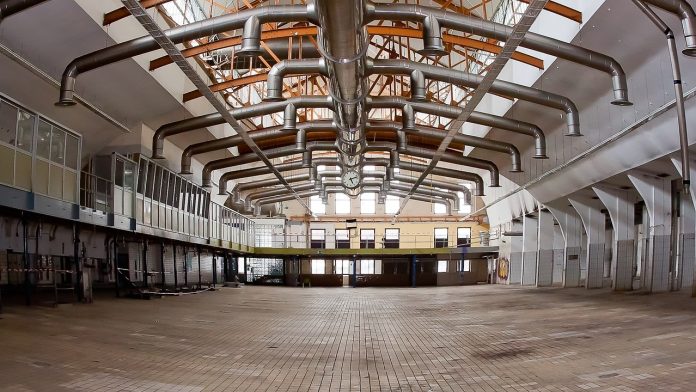Ventilation systems (maintaining indoor-outdoor air exchange, essential for both the quality of air and proper temperature control and moisture management). Ventilation systems are crucial to remove pollutants and control humidity as well as to improve comfort indoors. Hence, every house/office/industrial setup needs to be properly ventilated so that it remains free from dust particles, carbon dioxide and VOCs.
Types of Ventilation Systems
Natural Ventilation
The natural ventilation combines the forces of wind and thermal buoyancy to move air through windows, vents, or other openings. Its cost is very reasonable but limited by weather and inconsistent airflow, making it only suitable for milder climates.
Mechanical Ventilation
Mechanical systems rely on fans and ducts to manage air exchange, offering greater control over airflow and air quality. Common types include exhaust, supply, and balanced systems, often seen in homes and commercial buildings.
Hybrid Ventilation
Hybrid systems combine natural and mechanical ventilation, switching between the two based on environmental conditions. These are ideal for spaces requiring more flexibility in managing indoor air quality, especially in climates with varying seasons.
Components of Ventilation Systems
Air Ducts
Ducts transport air throughout the building, ensuring proper air distribution. Poorly designed or maintained ducts can lead to inefficiency and energy loss.
Ventilators and Fans
Fans help regulate the flow of air, with different types (axial, centrifugal) suited for specific applications. They ensure consistent air exchange in both residential and industrial settings.
Filters
Filters trap dust, pollen, and pollutants, maintaining clean indoor air. Regular filter maintenance is crucial to prevent clogging and ensure optimal performance.
Heat Recovery Units (HRVs)
HRVs improve energy efficiency by transferring heat between incoming and outgoing air, reducing heating and cooling costs.
Benefits of Ventilation Systems
Proper ventilation has numerous advantages, including:
Improved Air Quality: Ventilation removes indoor pollutants, allergens, odors and provides fresh breathable air.
Energy Efficiency: High efficiency systems such as HRVs help to reduce the need for heating and cooling, which reduces overall energy usage.
Moisture Control: By managing humidity, ventilation keeps mold at bay and moisture from causing damage. Health and Comfort: Healthful fresh outdoor air circulation can increase comfort and commercial productivity through improving focus and productivity in commercial environments.
Health and Comfort: Fresh air circulation improves comfort and can enhance focus and productivity in commercial environments.
Choosing the Right Ventilation System
Important factors in selecting a ventilation system are the size of the building, usage, climate, and goals for energy efficiency. Smaller residential areas are easily satisfied with simple exhaust or supply systems, but more commercial buildings need balanced or HRV systems for better control.
Energy efficiency is a key factor. Systems that recover energy or integrate smart technology can provide long-term savings and better control over air quality.
Applications of Ventilation Systems
Residential Ventilation
Ventilation systems in houses control the flow of air through the kitchen, rest room, and dwelling house and hinder unfavorable moisture and contemporary-breath imposed bacteria. Increase outdoor air (whole-house ventilation system)
Commercial and Industrial Ventilation
In commercial spaces like offices, retail stores, and restaurants, ventilation systems ensure proper air circulation to accommodate high occupancy. Industrial systems are designed to manage pollutants from manufacturing processes, protecting workers and equipment.
Public Spaces
Ventilation systems in structures such as schools and hospitals are necessary to help keep the air clean in high density areas of people, which allows for a healthier environment.
Ventilation System Installation and Maintenance
Proper installation is crucial to ensure ventilation systems function effectively. Improper installation, which can cause weak airflow and energy waste, is the cause for such a problem. To ensure the system works efficiently and serves for a longer time, the yearly check should be done and the replacement or cleaning of the filters and ducts inspection are some other maintenance activities to be performed. The regular checks will help spot potential problems early and thus eliminate costly repairs or equipment replacement.
Innovations and Trends in Ventilation Systems
The use of smart ventilation systems that are remotely monitored and controlled through apps significantly contributes to achieving better usability and flexibility. Energy recovery technologies are a known trend in the construction industry now, and in both residential and commercial structures more and more HRV work is done to reduce the environmental impact of buildings by ensuring the quality of air in the ventilation system. Green technologies, such as sustainable materials and energy-efficient designs, are encouraging the next steps in ventilation improvement which has an invisible role in the outside environment.
Conclusion
Ventilation systems provide important effects such as improving the quality of indoor air, being energy efficient, providing comfort and health. No matter if you’re looking for a residential or even more complex solution for an industrial building, determining what type is most suitable and its benefits, as well as applications, will lead to the right choice. Smart technology and energy recovery make ventilation systems a worthwhile investment for any building since they end up becoming more efficient with time. Proper installation and regular maintenance ensure long-lasting performance as well as healthier environments within buildings.



 Bitcoin
Bitcoin  Ethereum
Ethereum  Tether
Tether  XRP
XRP  Solana
Solana  USDC
USDC  Cardano
Cardano  TRON
TRON  Lido Staked Ether
Lido Staked Ether  Avalanche
Avalanche  Toncoin
Toncoin